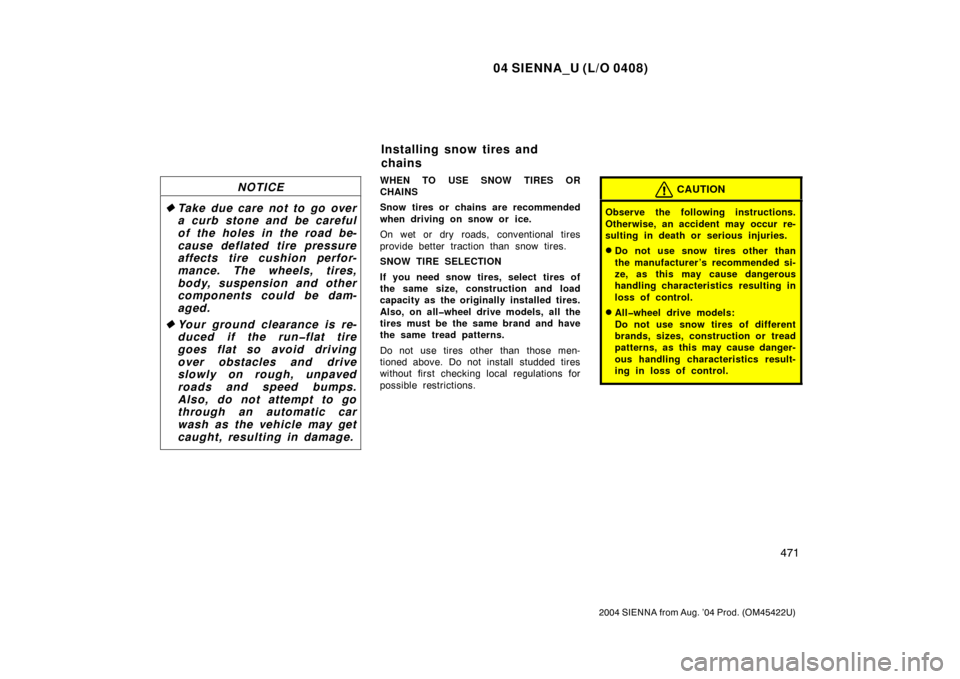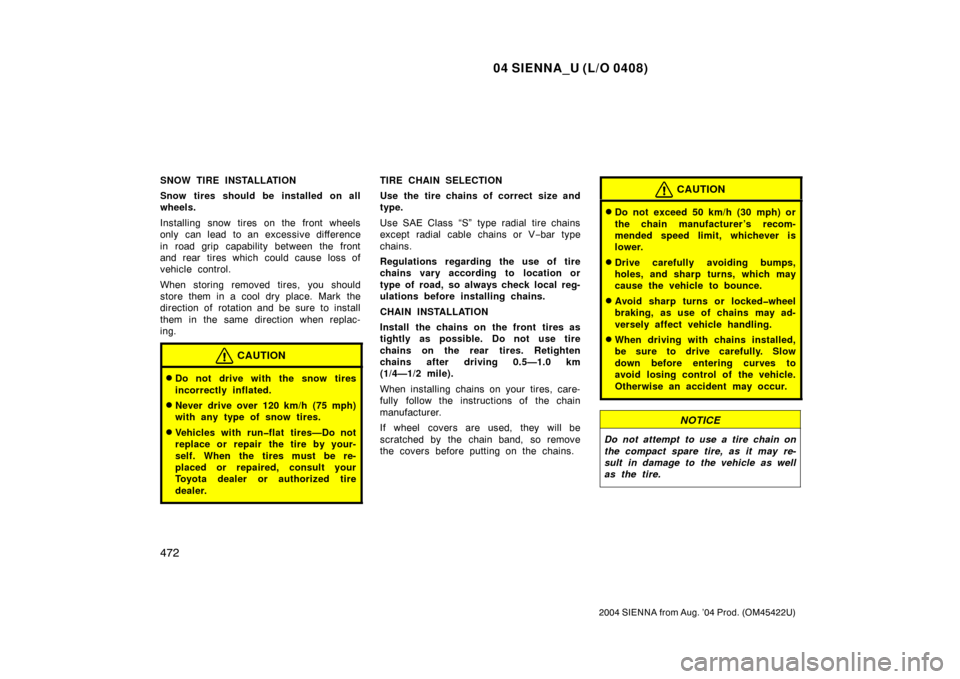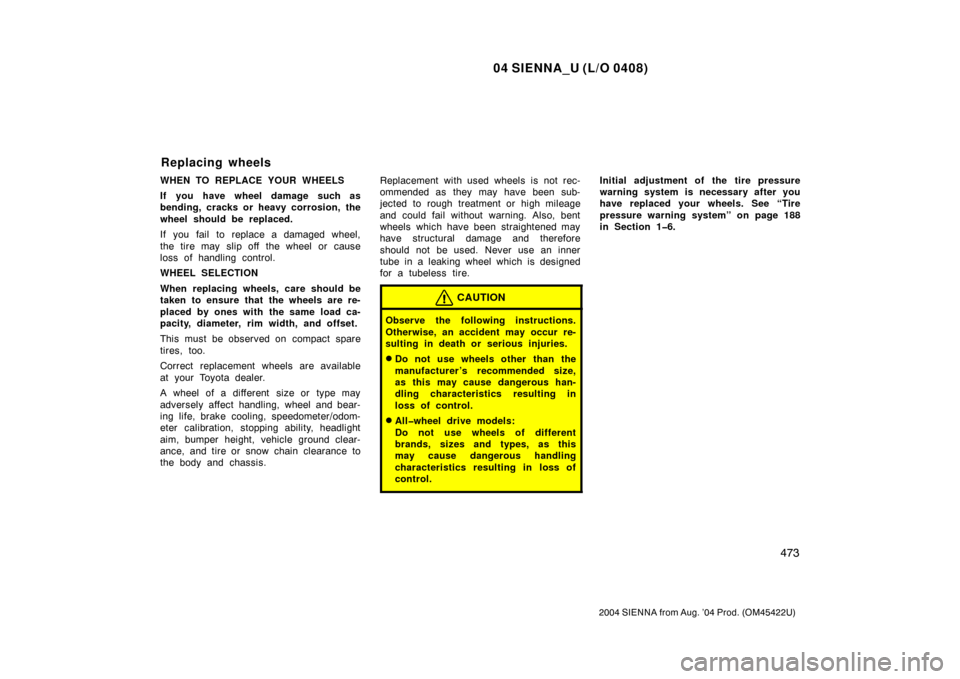Page 477 of 506

04 SIENNA_U (L/O 0408)
471
2004 SIENNA from Aug. ’04 Prod. (OM45422U)
NOTICE
�Take due care not to go over
a curb stone and be careful
of the holes in the road be-
cause deflated tire pressure
affects tire cushion perfor-
mance. The wheels, tires,
body, suspension and other
components could be dam-
aged.
� Your ground clearance is re-
duced if the run�flat tire
goes flat so avoid driving
over obstacles and drive
slowly on rough, unp aved
roads and speed bumps.
Also, do not attempt to go
through an automatic car
wash as the vehicle may get
caught, resulting in damage.
WHEN TO USE SNOW TIRES OR
CHAINS
Snow tires or chains are recommended
when driving on snow or ice.
On wet or dry roads, conventional tires
provide better traction than snow tires.
SNOW TIRE SELECTION
If you need snow tires, select tires of
the same size, construction and load
capacity as the originally installed tires.
Also, on all�wheel drive models, all the
tires must be the same brand and have
the same tread patterns.
Do not use tires other than those men-
tioned above. Do not install studded tires
without first checking local regulations for
possible restrictions.CAUTION
Observe the following instructions.
Otherwise, an accident may occur re-
sulting in death or serious injuries.
�Do not use snow tires other than
the manufacturer ’s recommended si-
ze, as this may cause dangerous
handling characteristics resulting in
loss of control.
�All�wheel drive models:
Do not use snow tires of different
brands, sizes, construction or tread
patterns, as this may cause danger-
ous handling characteristics result-
ing in loss of control.
Installing snow tires and
chains
Page 478 of 506

04 SIENNA_U (L/O 0408)
472
2004 SIENNA from Aug. ’04 Prod. (OM45422U)
SNOW TIRE INSTALLATION
Snow tires should be installed on all
wheels.
Installing snow tires on the front wheels
only can lead to an excessive difference
in road grip capability between the front
and rear tires which could cause loss of
vehicle control.
When storing removed tires, you should
store them in a cool dry place. Mark the
direction of rotation and be sure to install
them in the same direction when replac-
ing.
CAUTION
�Do not drive with the snow tires
incorrectly inflated.
�Never drive over 120 km/h (75 mph)
with any type of snow tires.
�Vehicles with run�flat tires—Do not
replace or repair the tire by your-
self. When the tires must be re-
placed or repaired, consult your
Toyota dealer or authorized tire
dealer.
TIRE CHAIN SELECTION
Use the tire chains of correct size and
type.
Use SAE Class “S” type radial tire chains
except radial cable chains or V −bar type
chains.
Regulations regarding the use of tire
chains vary according to location or
type of road, so always check local reg-
ulations before installing chains.
CHAIN INSTALLATION
Install the chains on the front tires as
tightly as possible. Do not use tire
chains on the rear tires. Retighten
chains after driving 0.5—1.0 km
(1/4—1/2 mile).
When installing chains on your tires, care-
fully follow the instructions of the chain
manufacturer.
If wheel covers are used, they will be
scratched by the chain band, so remove
the covers before putting on the chains.CAUTION
�Do not exceed 50 km/h (30 mph) or
the chain manufacturer ’s recom-
mended speed limit, whichever is
lower.
�Drive carefully avoiding bumps,
holes, and sharp turns, which may
cause the vehicle to bounce.
�Avoid sharp turns or locked�wheel
braking, as use of chains may ad-
versely affect vehicle handling.
�When driving with chains installed,
be sure to drive carefully. Slow
down before entering curves to
avoid losing control of the vehicle.
Otherwise an accident may occur.
NOTICE
Do not attempt to use a tire chain on
the compact spare tire, as it may re-
sult in damage to the vehicle as well
as the tire.
Page 479 of 506

04 SIENNA_U (L/O 0408)
473
2004 SIENNA from Aug. ’04 Prod. (OM45422U)
WHEN TO REPLACE YOUR WHEELS
If you have wheel damage such as
bending, cracks or heavy corrosion, the
wheel should be replaced.
If you fail to replace a damaged wheel,
the tire may slip off the wheel or cause
loss of handling control.
WHEEL SELECTION
When replacing wheels, care should be
taken to ensure that the wheels are re-
placed by ones with the same load ca-
pacity, diameter, rim width, and offset.
This must be observed on compact spare
tires, too.
Correct replacement wheels are available
at your Toyota dealer.
A wheel of a different size or type may
adversely affect handling, wheel and bear-
ing life, brake cooling, speedometer/odom-
eter calibration, stopping ability, headlight
aim, bumper height, vehicle ground clear-
ance, and tire or snow chain clearance to
the body and chassis.Replacement with used wheels is not rec-
ommended as they may have been sub-
jected to rough treatment or high mileage
and could fail without warning. Also, bent
wheels which have been straightened may
have structural damage and therefore
should not be used. Never use an inner
tube in a leaking wheel which is designed
for a tubeless tire.
CAUTION
Observe the following instructions.
Otherwise, an accident may occur re-
sulting in death or serious injuries.
�Do not use wheels other than the
manufacturer ’s recommended size,
as this may cause dangerous han-
dling characteristics resulting in
loss of control.
�All�wheel drive models:
Do not use wheels of different
brands, sizes and types, as this
may cause dangerous handling
characteristics resulting in loss of
control.
Initial adjustment of the tire pressure
warning system is necessary after you
have replaced your wheels. See “Tire
pressure warning system” on page 188
in Section 1�6.
Replacing wheels
Page 497 of 506
04 SIENNA_U (L/O 0408)
491
2004 SIENNA from Aug. ’04 Prod. (OM45422U)
STEERING
Wheel free play:Less than 30 mm (1.2 in.)
Power steering fluid type: Automatic transmission fluid DEXRON �II
or III
Tires
Ti r e siz e W heel siz e
P215/65R16 96T 240 (2.4, 35)
240 (2.4, 35) 17�61/2JJ
P225/60R17 98T
Compact spare tire Ti r e siz e k P a (k gf / c m
2 or bar, psi) Wheel size
T155/80R17 101M 420 (4.2, 60) 17 �4T
Wheel nut torque, N·m (kgf·m, ft·lbf): 103 (10.5, 76)
NOTE: For a complete information on tires (e.g. replacing tires or replacing wheels), see “Checking tire inflation pressure” through “Aluminum
wheel precautions”, pages 463 through 474, in Section 7 −2.
Tire size and cold tire inflation pressure:
Tire pressure,
kPa (kgf/cm
2 or bar, psi)
16�61/2JJ
Page:
< prev 1-8 9-16 17-24